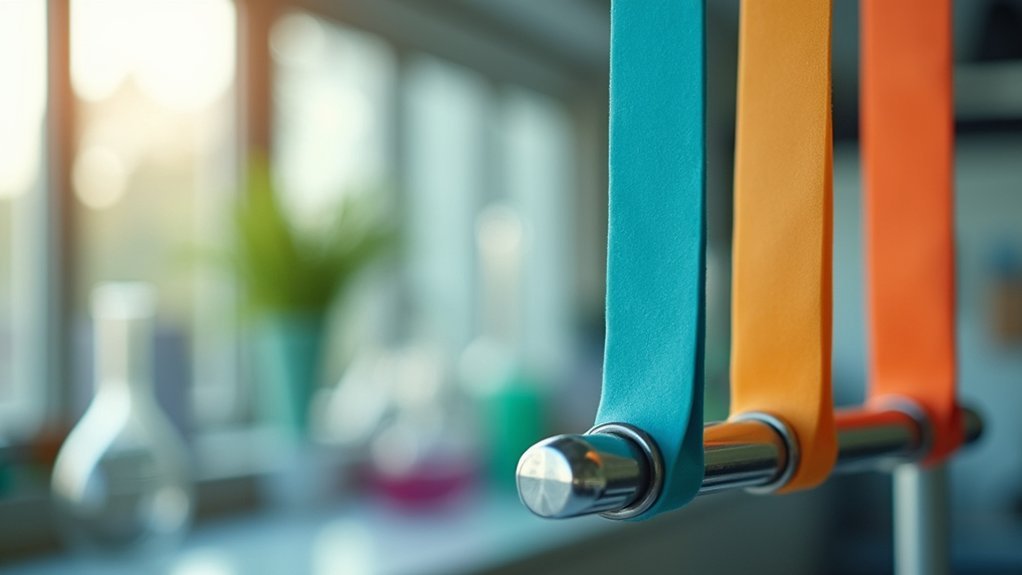Disclaimer: This content is for informational purposes only and does not replace professional medical advice, diagnosis, or treatment. Always consult a qualified healthcare provider before beginning any new exercise program.
Your home gym’s lighting does more than illuminate—it can orchestrate your body’s metabolic and hormonal responses. Most fitness enthusiasts overlook how strategic light exposure can dramatically enhance workout performance and recovery. By understanding circadian lighting principles, you’ll reveal a powerful yet invisible performance tool that synchronizes your body’s internal clock with external environmental cues. Intrigued by how simple light adjustments might revolutionize your fitness routine? Let’s explore the science behind optimizing your workout environment.
Key Takeaways
- Choose LED fixtures with color temperatures between 2,200-4,000K to strategically support circadian rhythms and optimize physiological performance in your home gym.
- Implement morning lighting strategies using cool, bright spectrums (5000K-6500K) that gradually increase in intensity to mimic natural sunrise and enhance cognitive alertness.
- Transition to warm, dim evening lighting (2700K-3000K) with reduced melanopic lux to promote melatonin production and facilitate post-workout recovery and relaxation.
- Position lighting to eliminate glare while maintaining a minimum of 250 equivalent melanopic lux (EML) to effectively stimulate circadian rhythm regulation during exercise.
- Select lighting solutions that dynamically adjust throughout the day, supporting metabolic activation, mental focus, and overall wellness by synchronizing with natural light progression.
Understanding Circadian Rhythms and Light

While your body’s internal clock might seem like a mysterious system, circadian rhythms are actually precise biological mechanisms that regulate critical functions throughout a 24-hour cycle. Your body’s master clock, located in the suprachiasmatic nucleus, responds dynamically to melanopic light signals from your environment, particularly natural light exposure.
These rhythms synchronize essential processes like sleep-wake cycles, hormone production, and metabolic functions. When you’re exposed to appropriate lighting that mimics natural daylight progression, you’re supporting your body’s intrinsic circadian rhythms. Strategic light intensity and color tuning can help optimize your physiological responses, enhancing alertness during workouts and promoting recovery during rest periods.
Understanding these light-driven biological patterns empowers you to design a home gym environment that works in harmony with your body’s natural rhythmic patterns.
The Science Behind Circadian Lighting

Because light plays a fundamental role in biological regulation, circadian lighting represents a sophisticated approach to manipulating artificial illumination to support human physiological processes. Your body’s response to light is mediated through melanopic receptors, which are critically sensitive to specific wavelengths:
Circadian lighting harnesses precise light wavelengths to optimize biological regulation and enhance human physiological responsiveness.
- Blue-spectrum light around 490nm most effectively triggers circadian rhythm modulation
- Melanopic ratio determines the potential for physiological light stimulation
- Equivalent melanopic lux (EML) measurements quantify circadian lighting effectiveness
- Natural light shifts serve as the ideal model for artificial lighting design
The science behind circadian lighting hinges on precisely mimicking the spectral characteristics of daylight. You’ll enhance your physiological responses by selecting lighting that dynamically adjusts color temperature and intensity, ensuring your body receives the right light signals throughout different activity phases in your home gym environment.
Impact of Lighting on Physical Performance

As research continues to reveal the intricate connections between light exposure and human performance, the impact of strategic lighting in home gyms emerges as a critical factor in optimizing physical training. Your natural circadian rhythm can be dramatically influenced by the melanopic ratio of lighting during exercise, directly affecting motivation, stamina, and overall workout effectiveness. By carefully selecting light spectrums that mimic natural sunlight, you’ll enhance mental focus, increase energy levels, and potentially improve performance by 10% to 25%. The right lighting doesn’t just illuminate your space; it strategically supports your body’s physiological responses, helping you shift from high-intensity workouts to restful recovery. Understanding and implementing circadian-aligned lighting can transform your home gym into a precision performance environment.
Designing Your Home Gym Lighting Strategy

Understanding the profound impact of light on physical performance sets the stage for a strategic approach to home gym illumination. Your lighting design should prioritize these key elements:
- Select LED fixtures with a color temperature range of 2,200-40,000K to simulate natural light variations
- Target a minimum of 250 melanopic lux to effectively support circadian rhythms
- Implement intensity tuning that mimics natural daylight progression
- Position lighting to eliminate glare and guarantee peak visibility
Optimal Light Spectrum for Workout Zones

It could be contended that the light spectrum is the hidden catalyst transforming ordinary workout spaces into high-performance zones. By targeting blue light wavelengths peaking at 490nm, you’ll enhance alertness and energy during exercise. Your ideal light spectrum isn’t just about brightness—it’s about strategic illumination that aligns with circadian rhythms.
Aim for a melanopic lux intensity of 250+ to stimulate your body’s natural biological responses. This precise lighting approach doesn’t just illuminate; it energizes. By carefully tuning light color temperatures throughout your workout, you’ll create an environment that supports peak physical performance. The science is clear: the right light spectrum can elevate your fitness experience from routine to remarkable, turning your home gym into a scientifically ideal wellness zone.
Morning vs. Evening Lighting Techniques
Precision in lighting design transforms your home gym from a mere exercise space to a circadian-synchronized wellness environment. Your morning lighting strategy should prioritize:
- Bright, cool spectrum (5000K-6500K) to stimulate alertness
- Gradual intensity increases mimicking natural sunrise
- High-intensity illumination promoting cognitive function
- Dynamic light shifts supporting metabolic activation
When evening arrives, shift your lighting approach to support recovery and sleep schedule preparation. Warm, dim lighting (2700K-3000K) signals your body to wind down, reducing melanopic lux to under 50 and encouraging melatonin production. This deliberate evening lighting technique helps reset your circadian rhythm, facilitating muscle repair and preparing your physiological systems for restorative sleep. By implementing these targeted morning and evening lighting techniques, you’ll optimize your home gym’s environmental conditions for peak performance and holistic wellness.
Implementing Circadian Lighting in Your Space
While transforming your home gym into a circadian-ideal wellness space requires strategic planning, selecting the right lighting fixtures becomes a critical first step. You’ll want to prioritize fixtures that deliver at least 250 equivalent melanopic lux, ensuring maximum stimulation of your sleep/wake cycle during workout sessions. Smart lighting systems can automatically adjust color temperatures between 2,200 and 6,500 Kelvin, promoting alertness during morning exercises and facilitating relaxation post-workout. By carefully calibrating light intensity throughout the day—brighter and cooler in morning hours, warmer and dimmer in evenings—you’ll create an environment that naturally supports your body’s circadian rhythms. Regular measurements and compliance with luminance standards will help maintain an effective, scientifically-aligned circadian lighting approach in your home gym.
Measuring and Adjusting Light Intensity
Because circadian lighting’s effectiveness hinges on precise measurements, home gym enthusiasts must adopt a systematic approach to evaluating light intensity. When measuring light, you’ll want to focus on these critical aspects:
- Use a height of 1.2 meters when taking measurements, ensuring accurate representation of your visual experience
- Employ devices that can specifically measure equivalent melanopic lux to track circadian stimulation
- Record light levels at different times of day to understand natural pattern variations
- Adjust lighting fixtures to maintain consistent 250 equivalent melanopic lux during exercise sessions
Your goal is to mimic natural daylight patterns, strategically tuning intensity throughout the day. By carefully measuring and adjusting light intensity, you’ll create an environment that supports your body’s intrinsic rhythms, enhancing both workout performance and overall wellness.
Technology and Tools for Circadian Light Control
As fitness enthusiasts seek ideal wellness through environment design, cutting-edge technology now enables precise circadian light control in home gyms. Circadian lighting technology offers sophisticated tools that help you optimize your lighting environment. Smart control systems allow you to program automated lighting schedules, seamlessly shifting color temperatures from energizing cool tones during workouts to relaxing warm hues in the evening.
Specialized devices measuring equivalent melanopic lux guarantee you’re receiving the right light intensity for circadian stimulation. By integrating tunable LED fixtures with high CRI and R9 values, you’ll experience superior color rendering and occupant comfort. Lighting control tools enable granular adjustments, empowering you to create a personalized lighting ecosystem that supports your body’s natural rhythms and enhances overall wellness.
Long-Term Health Benefits of Proper Gym Lighting
Optimizing your home gym’s lighting isn’t just about immediate workout performance—it’s a strategic investment in long-term wellness. By aligning your gym’s lighting with circadian rhythms, you’ll reveal profound health advantages:
- Enhanced sleep quality through regulated melatonin production, supporting thorough recovery and metabolic function
- Reduced risk of chronic diseases like obesity and cardiovascular issues by maintaining consistent energy levels throughout the day
- Improved mood and motivation, which sustains consistent exercise habits and mental resilience
- Neurological benefits from balanced light exposure, supporting cognitive function and stress management
Scientifically designed circadian lighting transforms your home gym from a mere exercise space into a holistic wellness environment. By understanding and implementing light’s biological impact, you’re not just working out—you’re proactively investing in your long-term health and physiological optimization.
Frequently Asked Questions
How Does Natural Light Affect Circadian Rhythm?
You’ll regulate your sleep-wake cycle through sunlight exposure, which suppresses melatonin during daytime and signals your body’s internal clock. This natural process directly impacts your sleep quality, helping you maintain ideal circadian rhythm and overall wellness.
Do Circadian Rhythm Lights Work?
Studies show 25% mood improvement with circadian lights. They’ll help regulate melatonin production by adjusting light color temperature, delivering significant health benefits that synchronize your body’s natural rhythms for enhanced wellness and energy.
How Do You Align Circadian Rhythm?
You’ll optimize sleep cycles by prioritizing natural light exposure during the day, maintaining consistent sleep schedules, and managing hormonal balance through strategic light interactions that align with your body’s innate circadian rhythms.
What Is My Natural Circadian Rhythm?
Your natural circadian rhythm is a unique biological clock that orchestrates sleep cycles, regulating hormones and bodily functions through a 24-hour pattern synchronized with light and darkness, influencing your energy, alertness, and restorative processes.
Conclusion
As you fine-tune your home gym’s lighting, you’ll discover a transformative synergy between illumination and performance. Coincidentally, the moment you align your LED fixtures with your body’s natural rhythms, you’ll experience heightened energy, improved recovery, and peak wellness. Your circadian-synchronized workout space becomes more than just a room—it’s a precision-engineered environment designed to elevate your physical and mental potential.



